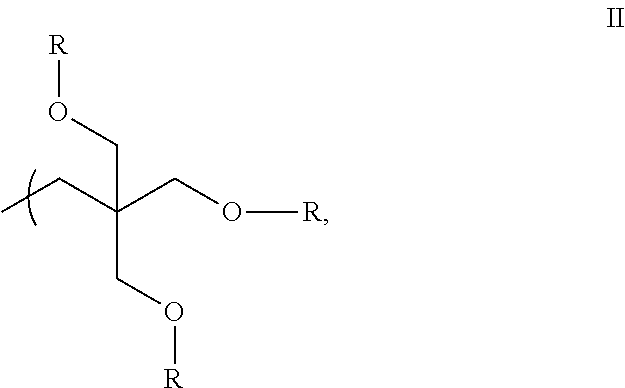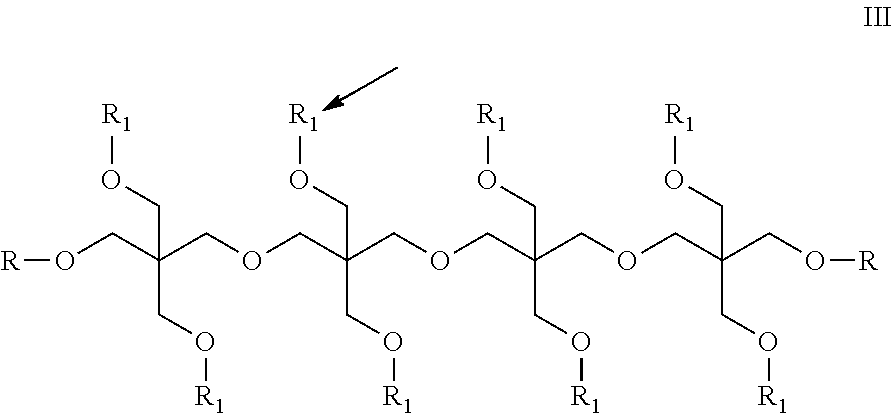Refrigeration Oil and Compositions with Carbon Dioxide Refrigerant
a technology of refrigerant and refrigerant, which is applied in the direction of lubricant composition, chemistry apparatus and processes, fuels, etc., can solve the problems of poor lubricity and/or load bearing properties impairing the ability of the compressor to adequately lubricate and protect the mechanical parts of the device, and the lubrication requirements of carbon dioxide-based refrigeration compressors and equipment are typically more demanding, and achieves excellent viscosity, lubrication and load
- Summary
- Abstract
- Description
- Claims
- Application Information
AI Technical Summary
Benefits of technology
Problems solved by technology
Method used
Image
Examples
example 1
[0092]Step 1: To a reactor equipped with a mechanical stirrer, Dean-Stark trap, condenser, nitrogen sparger, and vacuum source was charged 3418.5 grams (25.11 moles) of pentaerythritol, n-pentanoic acid (4880.9 grams, 47.79 moles), n-hexanoic acid (50.1 grams, 0.43 moles), n-heptanoic acid (50.1 grams, 0.39 moles), n-octanoic acid (50.1 grams, 0.35 moles), n-nonanoic acid (50.1 grams 0.32 moles), and a catalytic amount of methanesulfonic acid. The reaction mixture was heated to a temperature of about 170° C., vacuum was applied and water of reaction was removed and collected in the Dean-Stark trap while acid was returned to the reaction. The reaction was continued until the amount of equivalent to the water produced in the ester and ether forming reactions was collected.
[0093]Step 2: The reaction mixture containing a partially esterified mixture of pentaerythritol, dipentaerythritol, tripentaerythritol and higher pentaerythritol oligomers was cooled to about 134° C., the methanesulf...
example 2
[0094]The product of Example 1 was blended with di(2-ethylhexyl)neopentylglycol to afford a product possessing a kinematic viscosity of 67.6 cSt at 40° C. The final composition contained about 16 wt % of di(2-ethylhexyl)neopentylglycol and about 84 wt % of the product in Example 1. Other physical properties of the product are provided in Table 1.
example 3
[0095]Following the procedure of Example 1, a product with a viscosity of 54.8 cSt at 40° C. was obtained by reacting in Step 1: pentaerythritol (569.2 grams, 4.18 moles), n-pentanoic acid (999.8 grams, 9.79 moles), iso-pentanoic acid (10.3 grams, 0.10 moles), n-heptanoic acid (10.3 moles, 0.08 moles), iso-nonanoic acid (10.3 grams, 0.07 moles), and a catalytic amount of methanesulfonic acid, followed by final conversion to the fully esterified product using the same molar ratio of additional carboxylic acid in Step 2 as used in step 1.
PUM
 Login to View More
Login to View More Abstract
Description
Claims
Application Information
 Login to View More
Login to View More - R&D
- Intellectual Property
- Life Sciences
- Materials
- Tech Scout
- Unparalleled Data Quality
- Higher Quality Content
- 60% Fewer Hallucinations
Browse by: Latest US Patents, China's latest patents, Technical Efficacy Thesaurus, Application Domain, Technology Topic, Popular Technical Reports.
© 2025 PatSnap. All rights reserved.Legal|Privacy policy|Modern Slavery Act Transparency Statement|Sitemap|About US| Contact US: help@patsnap.com



